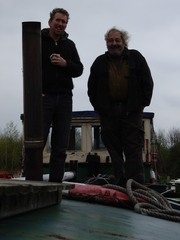Rust never sleeps
 Monday, June 16, 2008 at 08:00AM
Monday, June 16, 2008 at 08:00AM Mary and I went up for one day this weekend to carry on with the interior work. There was some more of the old fitout to remove and we're now up to 15 car loads that we've taken to the Hatfield tip. They know us by name now. On that note, the guy in the Donnington park services at the Costa stand greeted us with a cheery 'good to see you again' when we stopped for coffee on the way up on saturday afternoon. Routine is our friend after all.....
Once we'd got the rest of the old walls to the tip and removed the old bath and remaining fibreglass, we were left with a a large expanse of rusting steel. There was a covering of paint, but this came away in sheets and was peversely satisfying to scape all this off. Mary did most of this while I played with the engine and chatted to some locals ensured that the engine was functioning correctly (which it was).
Here is one of the piles of rust/paint that we swept up.
Once this was done, I pulled up some of the floor to have a look at how things are constructed underneath. Quite solidly as it turns out. Note to my sister: that is the adjustable spanner you brought me for my birthday, see, not every gift ends up on ebay.
The next steps are to figure out what type of insulation is best to use, as it'll determine how we treat the rust. If we use sprayfoam, then we'll need to just clean up and posibly prime the steel, if we use other materials (such as rockwool) then we'll use a special anti-rust oil (sprayfoam won't stick to this). I'm still undecided, the main drawback with sprayfoam to me is that you'll never be able to see whats going on underneath it, coupled with possible fire risk should welding be required on the hull sides in the future. I'll do some more research.
 Simon |
Simon |  2 Comments |
2 Comments | 